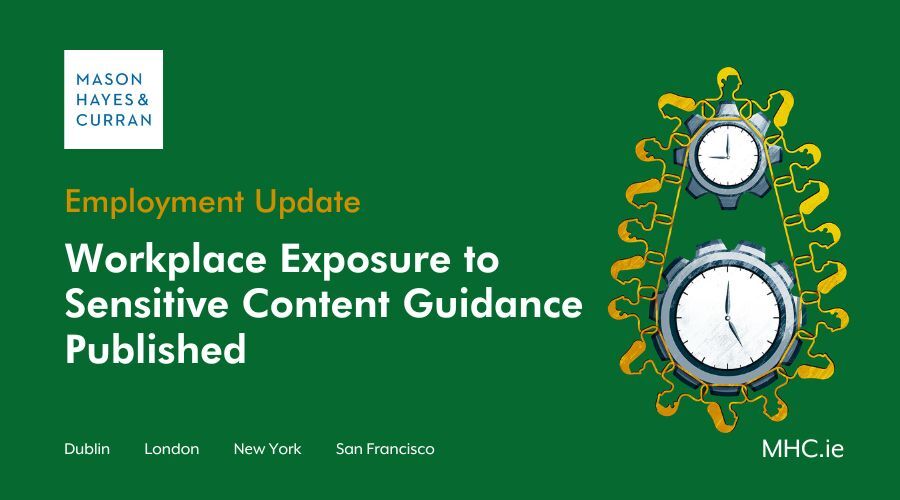Workplace Exposure to Sensitive Content Guidance Published

The HSA and the State Claims Agency recently published a guidance document on people employed in roles exposing them to sensitive content. Our Employment & Benefits team summarises this guidance and its potential implications for employers, employees and their representatives.
There is a duty on employers, under the Safety, Health and Welfare at Work Act 2005 (the Act) to manage the associated risks in places of work. The primary focus of this legislation is on the prevention or reduction of harm to an extent that is reasonably practicable.
Section 20 (4) of the Act states: ‘Specific tasks’…which “pose a serious risk” to safety, health or welfare require specific risk identification, assessment and protective and preventive measures by employers.
The exposure to and assessment of graphic material poses a specific known risk and therefore, is a ‘specific task’.
Sensitive content refers to:
- Text
- Pictures
- Graphs
- Illustrations
- Photographs
- Video clips, or
- Any other type of material of a particularly sensitive nature.
Examples include content relating to child abuse or graphic pictures of a violent death. These exposures can significantly impair the psychological health and wellbeing of those exposed. It is important to remember that psychological health or mental health comes within the area of ‘health’ for the purposes of occupational health duties under the Act.
General risk assessment guidelines
Employers are obliged to risk assess those reviewing and assessing sensitive content as part of their role. This means they need to assess the level of this known hazard and the risk of it causing harm. Regarding the hazard, there will be various risks involved and for each risk, the employer must prepare risk assessments. In addition, the employer must consult, design, develop and deliver systems to control and either:
- Prevent the hazard from becoming realised
- Minimise it, or
- Protect employees from its harmful effects.
Sensitive content risk assessment
The effect of exposure to sensitive content within a work setting is not easily foreseeable, nor will it be the same for each employee, or related to a single aspect of the exposure.
It is important that organisations maintain awareness of the impact the work is having on sensitive content moderators, for the long-term health and safety of employees. When analysing the effects of traumatic experiences, two levels must be considered, namely primary and secondary exposure to trauma.
- Primary exposure is when a person directly witnesses actual disturbing events in real life.
- Secondary trauma is seeing it second hand - through another medium such as a reenactment. This is particularly relevant to persons who review sensitive content.
Intervention supports and applying the hierarchy of controls
There are three main types of intervention supports, which can be applied in helping to reduce the risk:
- Primary prevention aims to prevent harm by preventing exposure - while also increasing tolerance to exposure through careful recruitment of suitable populations, enhancing resilience, and ensuring a supportive general work climate around the activity itself.
- Secondary interventions are those which rely on tools and proven evidence-based technique for the employee group exposed to the material, over and above more general interventions.
- Tertiary interventions focus on after the fact, ongoing safety climate and psychological safety initiatives, such as wellness programmes, Employee Assistance Programme (EAP), counselling supports and other therapeutic workplace interventions, some mandated and others voluntary, but all made available and easily accessible to the exposed individuals.
Risk elimination/substitution
If a role will involve reviewing sensitive content, it is unlikely that the hazard can be eliminated or substituted from the work environment. However, the recruitment processes should consider the population that may be exposed and if certain indicators of concern arise, they should not proceed with hiring.
Whenever possible, the roles should be staffed voluntarily by employees who have a clear understanding of the nature of the content, the level of exposure, and have been brought through rigorous, pre-exposure de-briefing and preparation.
If the organisation has policies or procedures that allow employees working with sensitive content to request alternative work placement, these workers should be informed about such policies upon hiring.
Engineering controls
Where elimination and substitution of the risk is not possible, organisations should consider what engineering controls could be applied to help reduce the risk to an appropriate level. There is an array of technology now available to organisations and all available options should be explored. Artificial Intelligence (AI) allows for blurring of imagery, forewarning sounds or visual cues, queue management arrangements and forced engineered time limits of typology exposure.
Administrative controls
There are a number of administrative factors that can be applied within the organisation including examining the length and frequency of exposure, the timing of exposure, any possible team dynamics and the cultural aspects in creating an environment of safety and trust. Other administrative controls include applying mandated breaks, de-briefings, opportunity for peer and manager supportive discussions, and time limits for exposures.
Employee supports
The organisation should ensure it has appropriate supports in place to address proactive and reactive needs. At a minimum, organisations should have an EAP available which is tailored to the role. Depending on requirements, employers may also require trained peer support staff in place, who can be deployed should critical incident exposures arise. To avoid stigma around mental health problems, consideration should be given to make psychological counselling mandatory for ‘high exposure’ employees.
Conclusion
In recent years, health and safety issues in this area of work have been brought to the attention of the inspection function in the Health & Safety Authority, as there are a growing number of related jobs located in the Republic of Ireland. The State Claims Agency also receives incident reports and claims in the area of exposure to sensitive content across the State sector.
The purpose of the guidance document is to provide evidence-based insights for employers, employees and their representatives on good practice and procedures for assessing, addressing and recording psychosocial risks related to exposure to sensitive content in workplaces. Managing these risks appropriately helps manage employee safety while also helping to reduce future incidents and claims arising.
For more information and expert advice, contact a member of our Employment Law & Benefits team.
The content of this article is provided for information purposes only and does not constitute legal or other advice.
Share this:




